by Tom Lake & Caitlin Green
We left the van just as it was getting light. Ahead of us was the longest climb either of us had ever attempted, 18 pitches that would take us to the top of Varasova Mountain, but it would be the descent that proved to be the real adventure.
We had driven to Greece from the UK and had been in the country for thirteen days when we received the following message:
21:30 22/03/2020
Emergency Alert
Civil Protection Greece: Starting tomorrow Monday at 6:00am nation-wide strict restrictions on movement apply…
We started urgently flicking through the guidebook to find our home for the months ahead. ‘How far can we drive tonight? Is there fresh water nearby? Where are we going to go to the toilet?!’ asked Cait. ‘Varasova is only a couple of hours away. There’s loads of climbing and a beach with showers.’ suggested Tom. We consulted with our friends, jumped in the van and headed south.
The first couple of weeks passed quickly, climbing most of the (sub 7a) single pitch routes, doing some rope work practise and digging latrines with our friends Barbara and Tim. We were itching for more of an adventure when we noticed a route called The Travel of Argonauts in the guidebook. 610m of climbing up the south west face of the mountain, fully bolted and with a crux of 6b+. Going by the tough grades at the roadside we thought we should go and have a look.
Being trad climbers from the UK, our usual style is slow and steady, not ideal for a route of this length. We knew we would need to average around thirty minutes per pitch to complete the route
and descend in daylight, so on the 2nd of April we went to check out the first four pitches. At the end of pitch 3, Cait struggled with the awkward mantle onto the belay ledge due to severe rope drag. The next pitch, is the hardest of the route, a 6b+ wall climb, with the crux just after exiting the cave belay. Luckily, it turned out to be easier than expected (although Tom did dog it). We started to feel that this was within our reach and we were excited to attempt the full route.
We watched the weather and, finally, clouds were forecast for the 12th of April. We set our alarm for 05:30 and packed our bags. The first few pitches went well. We were using our triple rated
ropes like half ropes and using long extenders to improve the rope drag. Cait flew up the 6b pitch and Tom got the 6b+ first try. Easier terrain above quickened our progress and we started to feel as though we were actually going to make it to the top. Unfortunately, the clouds in the forecast never materialised, so just after 11:00 the sun began to hit us. By 12:30, we had sweltered our way up to the half way ledge and were sheltering beneath a tree for lunch. Within the bowl of the mountain it felt like an oven. We are more used to climbing in the rain than in heat like this! We considered waiting until it cooled down but that was still six hours away and we would run out of daylight, food and water. We decided to push on but after two long slab pitches in the intense heat, our feet were swollen and painful and we were down to our last 500ml of water. Given the pandemic, and our decision to limit our exposure to risk, it seemed like a sensible idea to turn back. Four hours, ten abseils and a scramble later we were back on the ground. Next time we wouldn’t go up without clouds!
The days ticked by and the weather stopped us from making another attempt. The restrictions on movement were due to be lifted on the 4th of May; after living under the mountain for six weeks we didn’t want to wait around just to finish this climb! The forecast for the last day of the lockdown read ‘partly cloudy’, so we prepared for another early start, this time with a lot more water.
We started the approach at 06:30 and we were climbing by 07:00. Being familiar with these first four pitches, the climbing was easy. The weather was on our side and we made good progress to
the halfway ledge. The scramble up to pitch 10 was much more comfortable in our approach shoes and it felt like our toes could cope with nine more pitches.
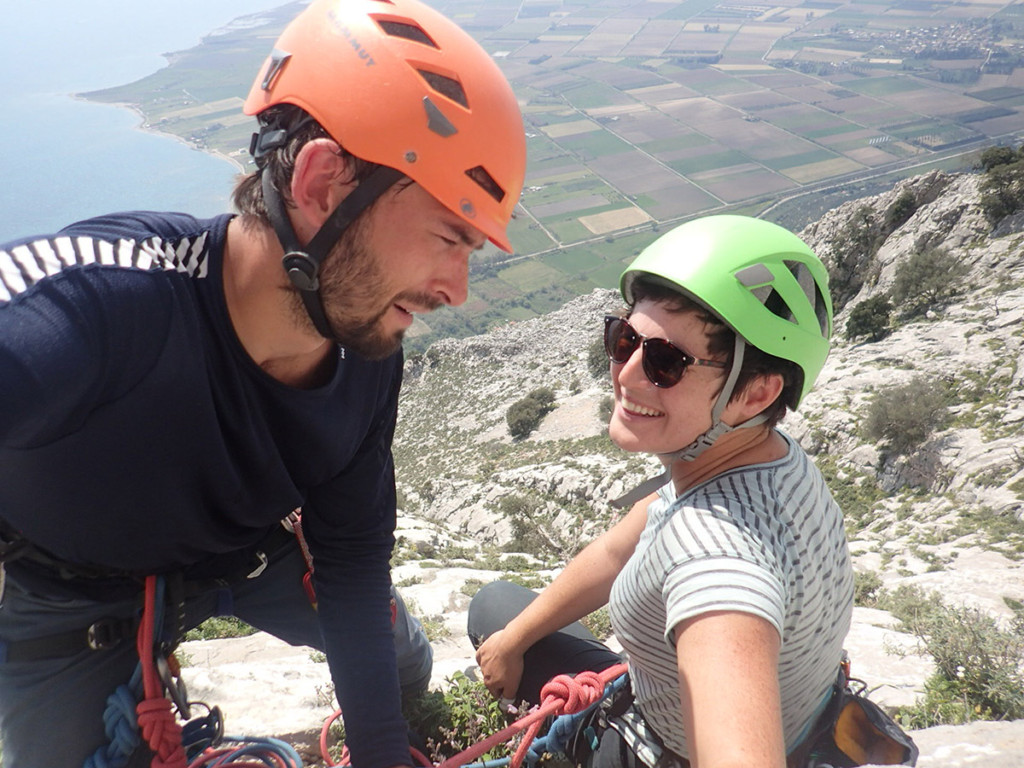
1st Attempt
We soldiered on but the pitches kept coming. Cait didn’t falter at the runout traverse on pitch 12, and at 15:35 we got to pitch 13. Only 6b with one point of aid, or 7a if you climb it free. Maybe it
was exhaustion, but this pitch felt much harder than 6b and Tom proceeded to aid his way up the whole crack system. This is where we started to struggle, the climbing felt harder and we stopped admiring the view, only noticing the sun getting lower in the sky. At this point we thought it would take longer to retreat by abseil than to finish the route and walk down so there was no option but to keep going. We reached the top at 20:15 after thirteen hours of climbing and were treated to incredible views across the Gulf of Corinth to Patras. With the sun setting we took a few quick photos and gobbled down our last sandwich.
The summit had a wild feeling to it, a stark contrast to what we are used to in the UK where you can’t fail to find footpaths complete with signposts and crowds of ramblers. Nevertheless, we made
our way to the col where the path began and, by a fallen telecoms mast, found the first of the red painted squares that would lead us back to Kryoneri. We knew from the approach how important these markers are for picking your way through this rough terrain.
With the adrenaline from the climb and summit wearing off, and fatigue well and truly setting in, we steadily made our way down the maze of goat paths. The bushes got denser, and the markers were increasingly difficult to find. Eventually, we lost the path, but we thought if we could just find a way over into the next gully, we would be down in no time.
After several hours of fighting our way through the thorny shrubs, we realised we couldn’t carry on. There are sheer cliffs all over the mountain, so finding a way through in the dark without any sign of a path would be impossible. To contribute to our worries, a fire truck had arrived in the village below flashing its lights and blaring in Greek over its loudspeaker. Not being able to understand a word, the only thing we could do was to ignore it and weigh up our options, all fairly undesirable:
1) Hike back to the top of the mountain and abseil down the route.
2) Traverse north east to where we could see the terrain was less steep.
3) Try to get some sleep and look for the path in daylight.
It was 01:00. Neither of us could stomach option one or two as we reasoned that neither would have us arriving back to the van until at least 09:00. We had optimistic hopes of dinner and bed
earlier than that. It was a warm night and we looked around for somewhere flat to lie down in between the boulders and bushes. We used our bag and one rope to make a mat to lie on and, unsuccessfully, draped our second rope over us as a makeshift blanket and tried to get some sleep. Once we’d stopped moving, we got colder and colder.
At 02:00 Tom tabled Option Four: To hike back up the mountain to regain the trail and follow it back to the ground, we probably should have thought of this three or four hours earlier! Although Cait initially resisted the idea of walking uphill again, we both reasoned that this would warm us up and be the quickest way down. After finding a marker, we couldn’t risk losing it again so we started a relay. One person would stand at the marker and the other would search ahead. The next three hours was the longest, darkest, hungriest and thirstiest game of hide-and-seek we have ever played. One quite cruel element of the game was just how much red lichen there was up there that looked like faded red paint!
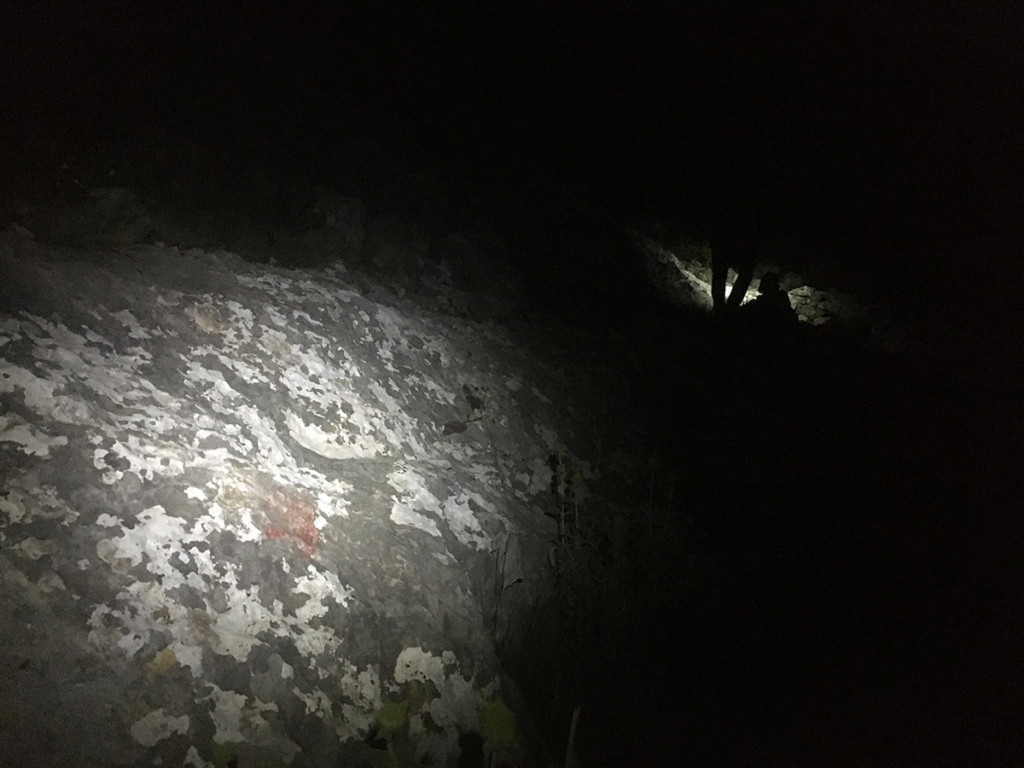
Marker on Descent
We ran out of food and water, our feet ached and our hands were so raw we could hardly bear to touch the boulders as we scrambled over them. After twenty three hours, we arrived back at the
van. We just about managed to eat a bowl of cereal each and as the sun started to rise we crawled into bed. It was the first day we were officially allowed to move from our lockdown campsite in over six weeks, but that could wait.
At lunchtime we had a visit from Jim, a local firefighter whose colleagues had been checking on us the night before. He was glad to find that we had got down safely and explained that somebody in
the village had worried that we were lost (which we were) and needed rescue (which thankfully we didn’t). After consulting with the police, they had decided not to send a rescue team up the mountain because there were no reports of missing people. We apologised for the trouble and thanked them for looking out for us.
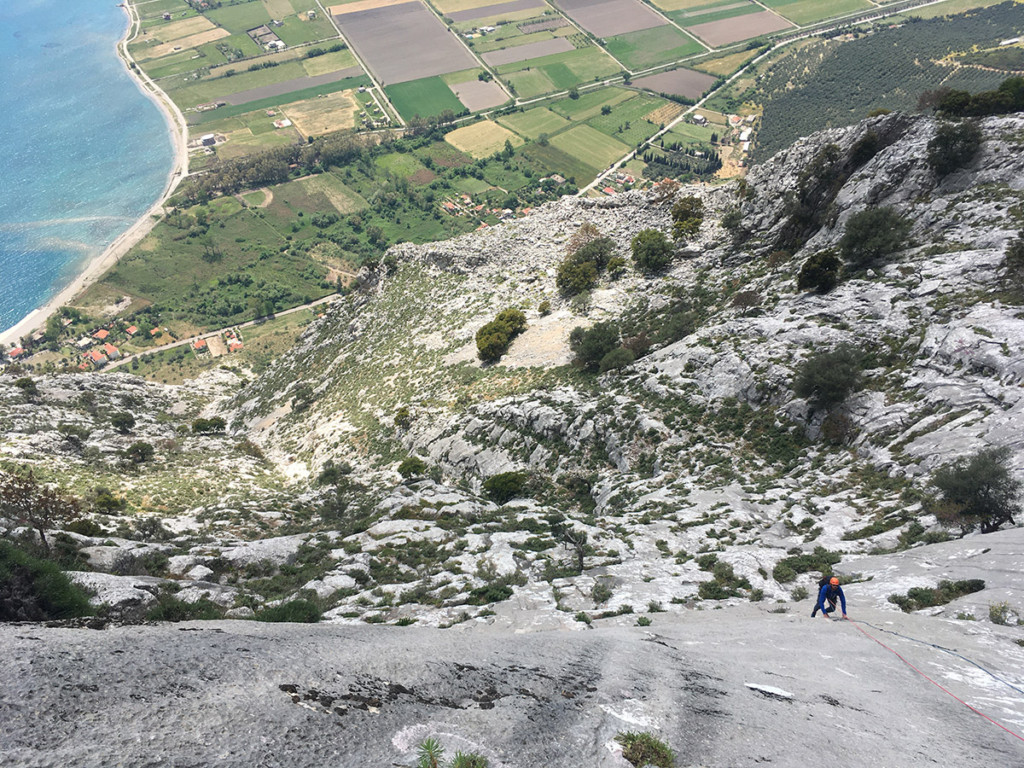
There aren’t many routes like this in Europe, and despite the traumatic descent, we both thoroughly enjoyed the adventure. However, we drove away from Varasova thinking we would stick to single pitch routes for the next few weeks.
P.S. If you want to give it a go, give Fireman Jim a heads up +30 693 0698881.







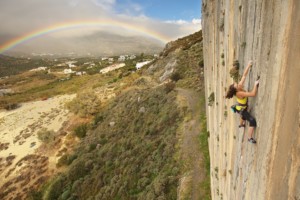


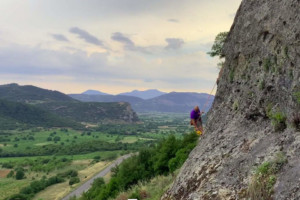

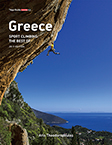


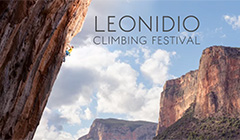

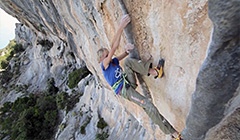

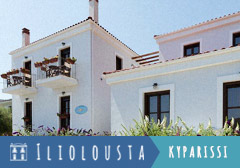

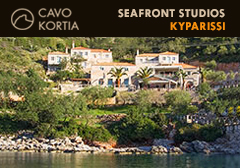


2 Comments
George
Hello, nice to read your story! It is things like this that stay in memory. I did the Argonauts several years back. I agree that the 7a pitch is more sustained than 6b and some aid. Probably the overall grade is less than 7a but there are several moves with grade more than 6b. The second 6a+ pitch after that is probably harder than the grade given. By the way, I heard that the belay bolts in the first 6b pitch had collapsed because of a storm some years back. Have they been replaced?
Another year my son and I climb the ridge line in Varasova-access by boat-all trad. We started late and arrived late on the top and lost our way down in the dark. The fire truck again arrived to rescue us. They found our phone number and I reassured them that we were OK. We slept on the mountain and next day we came down. We had slept 50m form the path! The firemen check on us as soon as we had arrived at the village. I climbed the ridge one more time since then but we started early this time!
Take care and with more adventures,
George
Harry Slater
In the middle of a very hot week, we noticed our first cloudy day in Greece was when we were in Varasova…and we thought we’d have to give this a go! This article was very helpful when we were prepping, so thank you.
We checked out the approach the afternoon before as we knew we’d be doing it in the dark and didn’t want to waste time trying to find the base of the climb.
Day of the climb we set off from the car just before 6am and were climbing by 6.40am just as it was light enough to go without head torches. We went as fast as we could and go to the terrace at 10:15am.
Finding the second half of the climb was fine (stay slightly to the right), but took longer than the 20 minutes described in the book. I agree with George’s comments on the difficulty…pitch 13 harder than 6B, not 7A, pitch 15 hard for 6A+. We got to the top at 3:45pm.
All bolts were in very good condition, and pretty close together on all harder sections. There were run outs on the easier parts, but we always felt safe. The book says 14 qds, but there was at least one pitch where you’d need 16 if you clipped all the bolts.
The descent even in broad daylight with I think what must be repainted red markers everywhere (they are currently a lot more visible than in the photo in the article) was harder than we were expecting! Tricky underfoot, steep and a long way. It took us over 2 and a half hours…we weren’t rushing, but we also weren’t taking our time. Back at the car at 6.30pm, so about 12.5 hour round trip.
Given the current excellent state of the bolting and the descent markers, would thoroughly recommend giving this a go now! As in the article, wait for a cloudy day and set off early 🙂
Thanks again for the helpful article and comment,
Harry